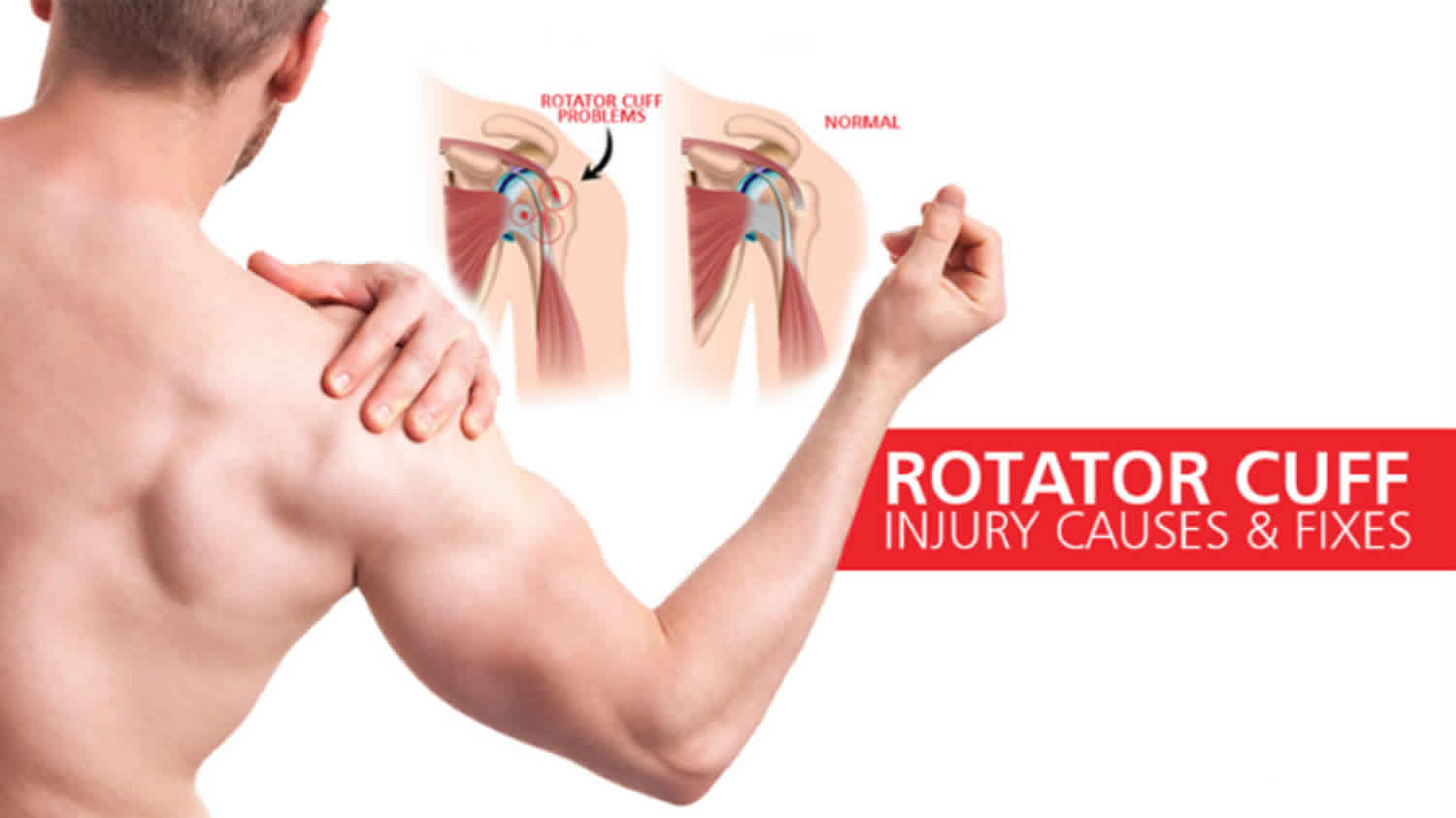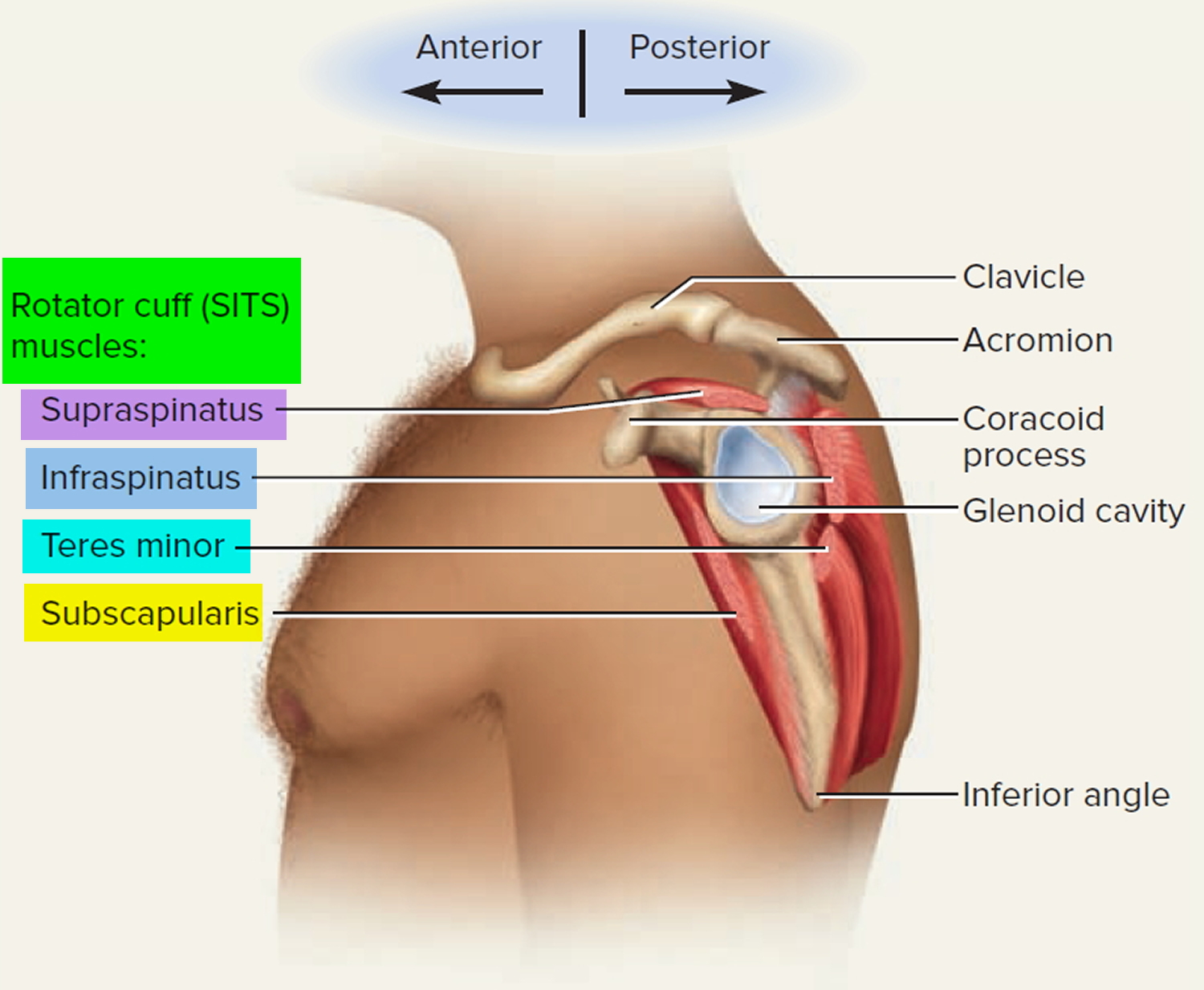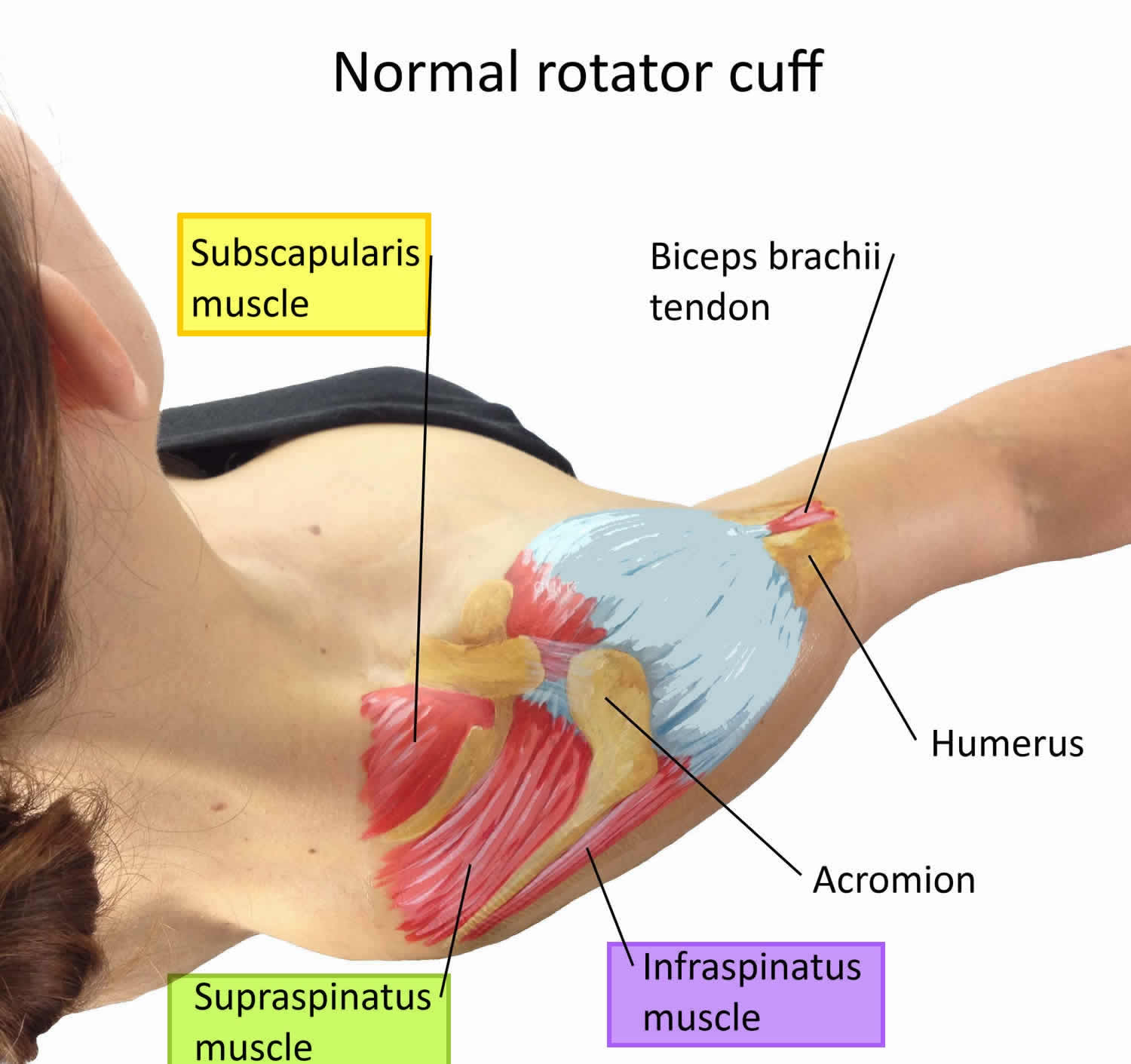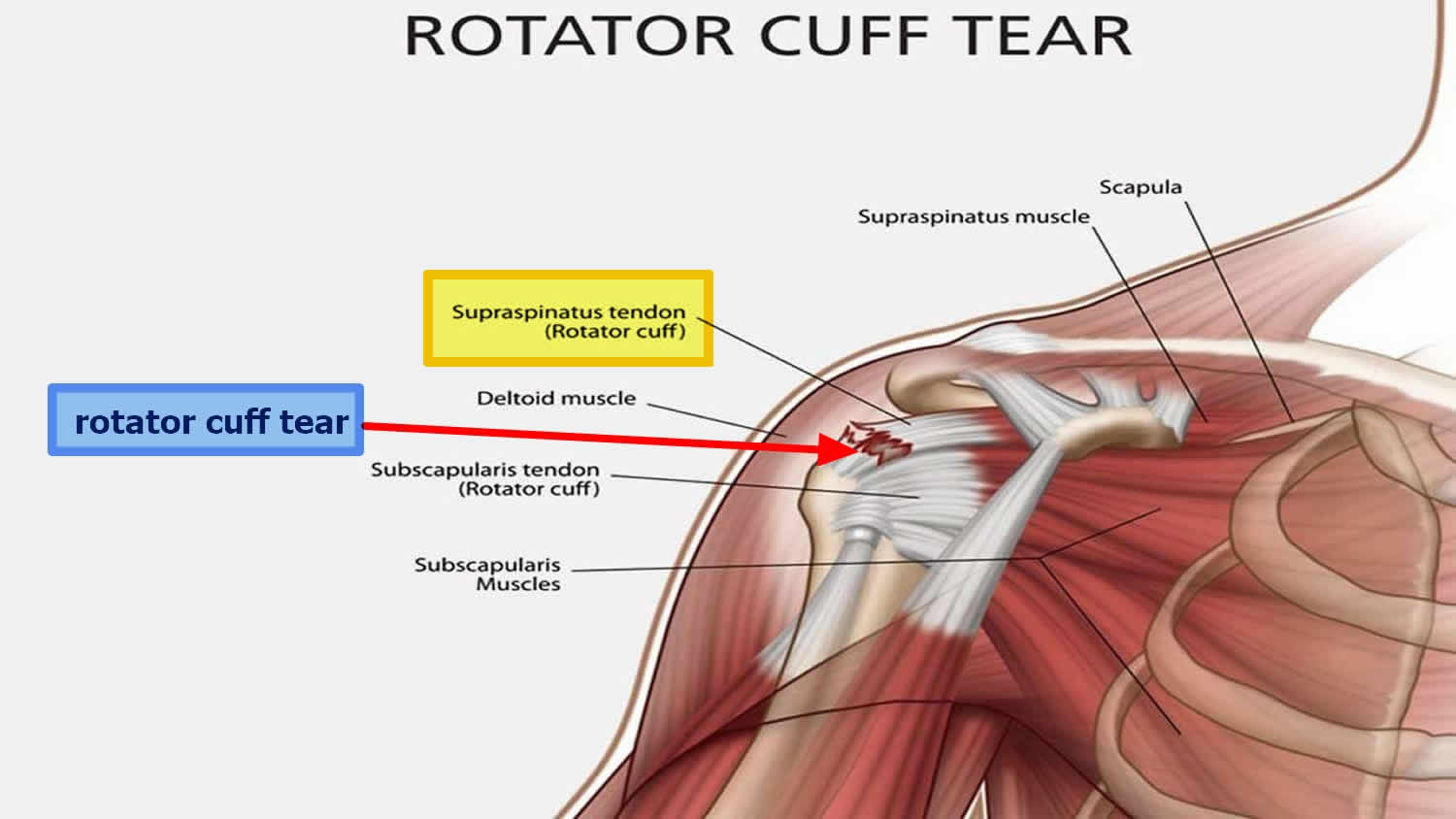What is a rotator cuff injury
Rotator cuff injury is a common cause of shoulder pain. A rotator cuff injury is usually a strain or tear of the rotator cuff – the muscles, tendons and joint capsule that stabilizes your shoulder. Rotator cuff injury often involves a tear to the rotator cuff tendons (the thick bands of tissue that connect the muscles to the bones).
The rotator cuff is the group of four muscles and their tendons at your shoulder joint. They form a cuff around the head of the upper arm bone (the humerus). They help the shoulder move. The most common site of a tear is in the supraspinatus tendon. Severe injuries can cause several of the tendons and muscles to tear.
Rotator cuff injuries occur most often in people who repeatedly perform overhead motions in their jobs or sports. Examples include painters, carpenters, and people who play baseball or tennis. The risk of rotator cuff injury also increases with age.
Rotator cuff injury can range from simple inflammation to tears of the muscles or tendons. It is also called rotator cuff syndrome, rotator cuff tear, rotator cuff tendonitis, and shoulder impingement syndrome. Rotator cuff injury can develop quickly, but often develops gradually over time.
The main causes of rotator cuff injury are:
- repetitive shoulder movement – from sports like basketball and jobs like painting
- overloading of the joint by heavy lifting
- an accident, such as a fall
- poor posture
- general wear and tear with age
Rotator cuff injury symptoms:
It is possible to have rotator cuff injury and not notice any symptoms.
When symptoms become noticeable they can include:
- pain and tenderness in the shoulder
- weakness of the shoulder
- pain when sleeping on the affected side
- numbness and tingling in the affected arm or hand
- restricted shoulder movement
Rotator cuff injury can often be treated using therapies such as physiotherapy and medication. Surgery may be an option in severe cases.
Many people recover from rotator cuff disease with physical therapy exercises that improve flexibility and strength of the muscles surrounding the shoulder joint.
Sometimes, rotator cuff tears may occur as a result of a single injury. In those circumstances, medical care should be provided as soon as possible. Extensive rotator cuff tears may require surgical repair, transfer of alternative tendons or joint replacement.
Most cases of rotator cuff injury can be treated by:
- Avoiding repetitive overhead tasks and lifting away from the body
- Rest
- Heat or cold to the sore area
- Medicines that reduce pain and swelling — pain killers, anti-inflammatory drugs and, in some cases, corticosteroid injections
- Treatment such as physiotherapy
- Electrical stimulation of muscles and nerves
- Ultrasound
If you have a severe injury, surgery may be an option.
When to see a doctor
Shoulder pain that is short-lived may be evaluated by your family doctor. See your doctor right away if you have immediate weakness in your arm after an injury.
How long does rotator cuff injury take to heal?
A minor rotator cuff injury often heals on its own, with proper care. If you think you’ve injured your rotator cuff, try these steps:
- Rest your shoulder. Stop doing what caused the pain and try to avoid painful movements. Limit heavy lifting or overhead activity until your shoulder pain subsides.
- Apply ice and heat. Putting ice on your shoulder helps reduce inflammation and pain. Use a cold pack for 15 to 20 minutes every three or four hours. After a few days, when the pain and inflammation have improved, hot packs or a heating pad may help relax tightened and sore muscles.
- Take pain relievers. Over-the-counter pain relievers such as ibuprofen (Advil, Motrin IB), naproxen sodium (Aleve) or acetaminophen (Tylenol, others) may be helpful.
See a doctor if it doesn’t start feeling better after 2 weeks. It can take 4 to 6 weeks to recover fully from mild rotator cuff injury.
If I have a painful rotator cuff and keep using it, will this cause further damage?
A rotator cuff tear can extend or get larger over time. This can occur with repetitive use or a re-injury. It is common for patients with known rotator cuff disease to have acute pain and weakness following a minor injury. This likely represents extension of an existing tear.
If you know you have a rotator cuff tear, then worsening pain and decreasing strength may mean the tear is getting larger.
What is the rotator cuff
The rotator cuff is a group of four muscles that come together as tendons to form a “cuff” over the head of the humerus (upper arm bone). The rotator cuff is a group of muscles and their tendons that hold the shoulder joint in place by attaching the shoulder blade to the humerus (upper arm bone) and covering the head of the humerus. The rotator cuff stabilises the shoulder joint and helps move the shoulder. The 4 muscles (and their tendons) that make up the rotator cuff are:
- the supraspinatus;
- the infraspinatus;
- the subscapularis; and
- the teres minor.
The four muscles—supraspinatus, infraspinatus, subscapularis and teres minor—originate from the scapula (shoulder blade). The long head of the biceps tendon is also often included in rotator cuff pathology. The rotator cuff tendons attach to the head of the humerus in special spots referred to as the greater and lesser tuberosities.
The rotator cuff tendons cover the head of the humerus (upper arm bone), helping keep the head of the humerus in your shoulder joint and helping you to raise and rotate your arm.
There is a lubricating sac called a bursa between the rotator cuff and the bone on top of your shoulder (acromion). The bursa allows the rotator cuff tendons to glide freely when you move your arm. When the rotator cuff tendons are injured or damaged, this bursa can also become inflamed and painful.
Some of the actions of the rotator cuff are to rotate the upper arm towards the body (internal rotation) and away from the body (external rotation), and to help raise the arm (abduction).
The supraspinatus assists in elevation (abduction) of the arm; infraspinatus and teres minor in external rotation, and; subscapularis in internal rotation.
Figure 1. Shoulder joint rotator cuff muscles
Figure 2. Shoulder joint (lateral view)
 Figure 3. Full thickness rotator cuff tear – the red arrow indicate a full-thickness tear in the supraspinatus tendon, the most common location for rotator cuff tears.
Figure 3. Full thickness rotator cuff tear – the red arrow indicate a full-thickness tear in the supraspinatus tendon, the most common location for rotator cuff tears.Rotator cuff injury causes
Causes of a rotator cuff tear may be from a single incident, such as falling on your arm or outstretched hand, or lifting something too heavy. However, most tears are of the degenerative type, resulting from the tendons wearing down as the body ages. A number of factors play a role in degenerative tears, including repetitive movements in sport or daily life such as overhead arm movements, such as in swimming, baseball, placing items on high shelves, painting and lifting. A reduction of blood supply to the region as we age, along with bony spurs can also contribute. Poor posture can also be a factor.
Risk factors for rotator cuff injury
Risk factors for a rotator cuff injury include:
- Being aged over 40. As you get older, your risk of a rotator cuff injury increases. Rotator cuff tears are most common in people older than 40.
- Being an athlete who does repetitive overhead or lifting activities. Athletes who regularly use repetitive arm motions, such as baseball pitchers, archers and tennis players, have a greater risk of having a rotator cuff injury.
- Construction jobs. Working as a painter, carpenter or other tradesperson who performs repetitive overhead activities that can damage the rotator cuff over time.
- Family history. There may be a genetic component involved with rotator cuff injuries as they appear to occur more commonly in certain families.
Rotator cuff injury prevention
If you are at risk of rotator cuff injuries or if you’ve had a rotator cuff injury in the past, daily shoulder stretches and strengthening exercises can help prevent future injury.
Most people exercise the front muscles of the chest, shoulder and upper arm, but it is equally important to strengthen the muscles in the back of the shoulder and around the shoulder blade to optimize shoulder muscle balance. Your doctor or a physical therapist can help you plan an exercise routine.
Rotator cuff injury signs and symptoms
The pain associated with a rotator cuff injury may:
- Be described as a dull ache deep in the shoulder
- Disturb sleep, particularly if you lie on the affected shoulder
- Make it difficult to comb your hair or reach behind your back
- Be accompanied by arm weakness
Symptoms of a rotator cuff injury include pain and tenderness in the shoulder, pain on elevating the arm, weakness of the shoulder, and pain when sleeping on the affected side. Pain from the tear may cause awakening at night. Testing of the range of movement and strength of the shoulder, along with special directed tests, can help the doctor determine which of the muscles or tendons has been torn. Sometimes rotator cuff tears can be without symptoms.
A torn cuff may make the shoulder weak, and make daily activities more difficult. It is a common injury, particularly in people over 40 years old. A tear in the rotator cuff will disrupt the normal functioning of the cuff itself and, depending on the severity of the tear, can result in a range of symptoms. Tears may be partial or full thickness, and occur as the result of an injury, or occur as part of the degenerative process.
A partial tear involves the tendon, but does not completely sever it. In some cases, fraying of the tendon can result in a partial tear, and progress to a complete, full thickness tear.
A complete or full thickness tear often occurs at or near the attachment of the tendon to the arm bone, or humerus and may cause significant disability, particularly in younger people.
Rotator cuff injury complications
Without treatment, rotator cuff problems may lead to permanent loss of motion or weakness, and may result in progressive degeneration of the shoulder joint. Although resting your shoulder is necessary for your recovery, keeping your shoulder immobilized for a prolonged time can cause the connective tissue enclosing the joint to become thickened and tight (frozen shoulder).
Rotator cuff injury diagnosis
Many things can cause shoulder pain and your shoulder joint is complex. So diagnosing rotator cuff injury can be challenging.
During the physical exam, your doctor will press on different parts of your shoulder and move your arm into different positions. He or she will also test the strength of the muscles around your shoulder and in your arms.
Rotator cuff injury test
In some cases, imaging such as X-ray, ultrasound or MRI may also be done.
- X-rays. Although a rotator cuff tear won’t show up on an X-ray, this test can visualize bone spurs or other potential causes for your pain — such as arthritis.
- Ultrasound. This type of test uses sound waves to produce images of structures within your body, particularly soft tissues such as muscles and tendons. It allows dynamic testing, assessing the structures of your shoulder as they move. It also allows a quick comparison between the affected shoulder and the healthy shoulder.
- Magnetic resonance imaging (MRI). This technology uses radio waves and a strong magnet. The images obtained display all structures of the shoulder in great detail. The quality of the images depends greatly on the quality of the equipment used.
Rotator cuff injury treatment
The mainstay of rotator cuff injury treatment includes treating the pain and restoring best possible function. This may include resting the shoulder from aggravating activities, taking anti-inflammatory medicines, ice and special exercises and physical therapy.
A minor rotator cuff injury often heals on its own, with proper care. If you think you’ve injured your rotator cuff, try these steps:
- Rest your shoulder. Stop doing what caused the pain and try to avoid painful movements. Limit heavy lifting or overhead activity until your shoulder pain subsides.
- Apply ice and heat. Putting ice on your shoulder helps reduce inflammation and pain. Use a cold pack for 15 to 20 minutes every three or four hours. After a few days, when the pain and inflammation have improved, hot packs or a heating pad may help relax tightened and sore muscles.
- Take pain relievers. Over-the-counter pain relievers such as ibuprofen (Advil, Motrin IB), naproxen sodium (Aleve) or acetaminophen (Tylenol, others) may be helpful.
Corticosteroid injections with local anaesthetic are useful in some cases, if other conservative treatments have not helped. Surgery may be needed in patients who have a large or full thickness tear, particularly if they are young, or for long term symptoms or significant weakness and poor function.
Injections
If conservative treatments haven’t reduced your pain, your doctor might recommend a steroid injection into your shoulder joint, especially if the pain is interfering with your sleep, daily activities or exercise. While such shots are often temporarily helpful, they should be used judiciously, as they can contribute to weakening of the tendon.
Physical therapy
Physical therapy is usually one of the first treatments your doctor may suggest. Exercises tailored to the specific location of your rotator cuff injury can help restore flexibility and strength to your shoulder. Physical therapy is also an important part of the recovery process after rotator cuff surgery.
Surgery
Many different types of surgeries are available for rotator cuff injuries, including:
- Arthroscopic tendon repair. In this procedure, surgeons insert a tiny camera (arthroscope) and tools through small incisions to reattach the torn tendon to the bone.
- Open tendon repair. In some situations, an open tendon repair may be a better option. In these types of surgeries, your surgeon works through a larger incision to reattach the damaged tendon to the bone. Compared to arthroscopic procedures, open tendon repairs typically heal in the same length of time but recovery may be more uncomfortable.
- Tendon transfer. If the torn tendon is too damaged to be reattached to the arm bone, surgeons may decide to use a nearby tendon as a replacement.
- Shoulder replacement. Massive rotator cuff injuries may require shoulder replacement surgery. To improve the artificial joint’s stability, an innovative procedure (reverse shoulder arthroplasty) installs the ball part of the artificial joint onto the shoulder blade and the socket part onto the arm bone.
Rotator cuff injury exercises
Rotator cuff exercises are important to prevent and treat injuries. They help strengthen your muscles and improve flexibility. Follow the recommended movements below.
Before you begin, you should assess your current range of motion. This will help to keep track of your progress. A doctor or physical trainer can assist you with this.
You should warm up your arms and shoulders first. This can consist of basic stretches. Then, you can move on to the strengthening exercises.
- Stretch 1: Cross your right arm straight across your chest to the left. Grip your upper right arm with your left hand. Hold for 30 seconds and then switch sides.
- Stretch 2: Lift your right arm up overhead then bend it behind your neck. Grip your right elbow with your left hand. Hold for 30 seconds and switch sides.
- Stretch 3: Stand with your feet slightly apart for the pendulum stretch. Bend forward at the waist and let your arms hang straight down. Keep your arm and shoulder muscles relaxed and swing your arms slowly back and forth. Do this for about 30 seconds.
- Stretch 4: Start in a standing position with your feet slightly apart. Place the end of a rolled-up towel in your right hand. Lift your right arm overhead and cross it behind your back. With your left arm, reach around behind your back and underneath to grab the bottom of the towel. Hold for 30 seconds and switch sides. Repeat 3 times. Over time, try to decrease the amount of space between your hands on the towel. Eventually, you may be able to remove the towel and hold onto your hands. The closer together your hands are, the better your shoulder flexibility.
- Stretch 5: Stand with your right side against a wall. Lift your right arm along the wall behind you to 90°. Turn your palm inward and hold for 30 seconds. Turn your palm outward and hold for 30 seconds. Switch sides.
Exercise 1
Lie on your right side on a table or bed. Your right arm should be extended overhead with your head resting on your arm. Place a rolled-up towel under your right armpit. Lift your left arm to shoulder height with your elbow bent 90°. Your left forearm should be forward with your palm facing down. Keep your left elbow in place and raise your left forearm. (Your arm motion should be going up.) Hold for 2 to 3 seconds and return to your starting position. Repeat and switch sides.
Exercise 2
Lie on your right side on a table or bed. Your right arm should be extended overhead with your head resting on your arm. Place a rolled-up towel under your right armpit. Lift your left arm to shoulder height with your elbow bent 90°. Your left forearm should be forward with your palm facing down. Keep your left elbow in place and lower your left forearm. (Your arm motion should be going down.) Hold for 2 to 3 seconds and return to your starting position. Repeat and switch sides.
Exercise 3
Lie on your right side on a table or bed. Your right arm should be extended overhead with your head resting on your arm. Place a rolled-up towel under your right armpit. With your left arm at your side, bend your elbow 90°. Your left forearm should be forward with your palm facing down. Keep your left elbow touching your side and raise your left forearm until it’s level with your shoulder. (Your arm motion should be going out, away from your body.) Hold for 2 to 3 seconds and return to your starting position. Repeat and switch sides.
Exercise 4
Lie on your right side on a table or bed. Your right arm should be extended overhead with your head resting on your arm. Place a rolled-up towel under your right armpit. With your left arm at your side, bend your elbow 90°. Your left forearm should be forward with your palm facing down. Keep your left shoulder in place and raise your left arm in line with your shoulder, about 45°. Your elbow should still be bent. Hold for 2 to 3 seconds and return to your starting position. Repeat and switch sides.
Things to consider
There are other options for the strengthening exercises. You can do them standing up. You can use hand weights or a resistance band to make the stretches more difficult. For each exercise, you should do 20 to 30 reps, 3 to 5 times a week.
Keep your range of motion small at the beginning and increase it over time. If you choose to use weights, start small and increase a little each week. Perform the exercises slowly. Jerky movements can cause pain or damage. Be careful if you have an injury or have had surgery on your rotator cuff.
You should be able to feel the stretches and exercises. However, they should not be painful. If you feel any pain, stop and talk to your doctor or physical therapist. You can ice your shoulder for up to 20 minutes. It’s best to use a plastic big filled with ice cubes instead of a gel pack.








